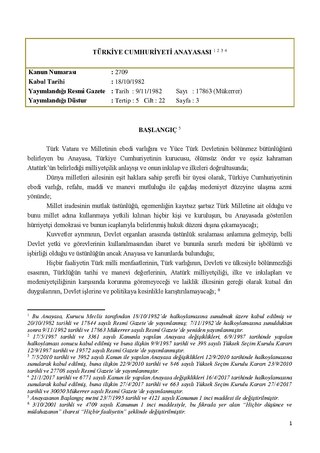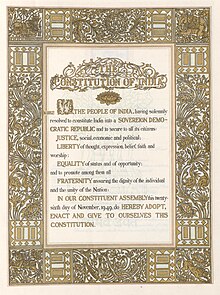
The Constitution of Pakistan, also known as the 1973 Constitution, is the supreme law of Pakistan. The document guides Pakistan's law, political culture, and system. It sets out the state's outline, the fundamental rights of the population, the state's law and orders, and also the structure and establishment of the institutions and the armed forces. Drafted by the government of Zulfikar Ali Bhutto, with additional assistance from the country's opposition parties, it was unanimously approved by the 5th Parliament on 10 April and ratified on 14 August 1973. The first three chapters establish the rules, mandate, and separate powers of the three branches of the government: a bicameral legislature; an executive branch governed by the Prime Minister as chief executive; and an apex federal judiciary headed by Supreme Court. The Constitution designates the President of Pakistan as a ceremonial Head of State who is to represent the unity of the state. The first six articles of the constitution outline the political system as federal parliamentary republic system; as well as Islam as its state religion. The Constitution also encapsulates provisions stipulating the legal system's compliance with Islamic injunctions contained in the Quran and Sunnah.

The Constitution of India is the supreme law of India. The document lays down the framework that demarcates fundamental political code, structure, procedures, powers, and duties of government institutions and sets out fundamental rights, directive principles, and the duties of citizens, based on the proposal suggested by M. N. Roy. It is the longest written national constitution in the world.

The Constitution of the Republic of Croatia is promulgated by the Croatian Parliament.

The Constitution of Bangladesh, officially the Constitution of the People's Republic of Bangladesh is the supreme law of Bangladesh. The document provides the framework that demarcates the Bangladeshi republic with a unitary, parliamentary democracy, that enshrines fundamental human rights and freedoms, an independent judiciary, democratic local government and a national bureaucracy.

The Fundamental Rights, Directive Principles of State Policy and Fundamental Duties' are sections of the Constitution of India that prescribe the fundamental obligations of the states to its citizens and the duties and the rights of the citizens to the State. These sections are considered vital elements of the constitution, which was developed between 1949 by the Constituent Assembly of India.
India since its independence in 1947 has been a secular state. The secular values were enshrined in the constitution of India. India's first prime minister Jawaharlal Nehru and Law Minister B.R Ambedkar are credited with the formation of secular values in the modern history of the country.
The basic structure doctrine is a common law legal doctrine that the constitution of a sovereign state has certain characteristics that cannot be erased by its legislature. The doctrine is recognised in India, Bangladesh, Pakistan, and Uganda. It was developed by the Supreme Court of India in a series of constitutional law cases in the 1960s and 1970s that culminated in Kesavananda Bharati v. State of Kerala, where the doctrine was formally adopted. Bangladesh is perhaps the only legal system in the world which recognizes this doctrine with an expressed, written and rigid constitutional manner through article 7B of its Constitution.
The Fundamental Rights in India enshrined in part III of the Constitution of India guarantee civil liberties such that all Indians can lead their lives in peace and harmony as citizens of India. These rights are known as "fundamental" as they are the most essential for all-round development i.e., material, intellectual, moral and spiritual and protected by fundamental law of the land i.e. constitution. If the rights provided by Constitution especially the Fundamental rights are violated the Supreme Court and the High Courts can issue writs under Articles 32 and 226 of the Constitution, respectively, directing the State Machinery for enforcement of the fundamental rights.
The Directive Principles of State Policy of India are the guidelines to be followed by the government of India for the governance of the country. They are not enforceable by any court, but the principles laid down there are considered 'Fundamental' in the governance of the country, which makes it the duty of the State to apply these principles in making laws to establish a just society in the country. The principles have been inspired by the Directive Principles given in the Constitution of Ireland which are related to socialjustice, economic welfare, foreign policy, and legal and administrative matters.

Hans Raj Khanna was an Indian judge, jurist and advocate who propounded the basic structure doctrine in 1973 and attempted to uphold civil liberties during the time of Emergency in India in a lone dissenting judgement in 1976. He entered the Indian judiciary in 1952 as an Additional District and Sessions Judge and subsequently was elevated as a judge to the Supreme Court of India in 1971 where he continued till his resignation in 1977.

The 42nd amendment, officially known as The Constitution Act, 1976, was enacted during the Emergency by the Indian National Congress government headed by Indira Gandhi.

Kesavananda Bharati Sripadagalvaru & Ors. v. State of Kerala & Anr., also known as the Kesavananda Bharati judgement, was a landmark decision of the Supreme Court of India that outlined the basic structure doctrine of the Indian Constitution. The case is also known as the Fundamental Rights Case. The court in a 7-6 decision asserted its right to strike down amendments to the constitution that were in violation of the fundamental architecture of the constitution.
The Constitution of the Philippines is the constitution or the supreme law of the Republic of the Philippines. Its final draft was completed by the Constitutional Commission on October 12, 1986, and ratified by a nationwide plebiscite on February 2, 1987.

The Constitution of Namibia is the supreme law of the Republic of Namibia. Adopted on 9 February 1990, a month prior to Namibia's independence from apartheid South Africa, it was written by an elected constituent assembly.
The Constitution of 1956 was the fundamental law of Pakistan from March 1956 until the 1958 Pakistani coup d'état. It was the first constitution adopted by independent Pakistan. There were 234 articles 13 parts and 6 schedules.
The Constitution of Jammu and Kashmir was the legal Constitution which established the framework for the state government of the Indian state of Jammu and Kashmir. The constitution was adopted on 17 November 1956, and came into effect on 26 January 1957. It was rendered infructuous on 5 August 2019 by an order signed by the President of India and ceased to be applicable on that date. It also included Ladakh.

The Constitution of Turkey, formally known as the Constitution of the Republic of Türkiye, also known as the Constitution of 1982, is Turkey's fundamental law. It establishes the organization of the government, and sets out the principles and rules of the state's conduct along with its responsibilities in regards to its citizens. The constitution also establishes the rights and responsibilities of the latter while setting the guidelines for the delegation and exercise that sovereignty belongs entirely and without doubt to the people.

Minerva Mills Ltd. and Ors. v. Union Of India and Ors. is a landmark decision of the Supreme Court of India that applied and evolved the basic structure doctrine of the Constitution of India.

The Twenty-fourth Amendment of the Constitution of India, officially known as The Constitution Act, 1971, enables Parliament to dilute Fundamental Rights through Amendments of the Constitution. It also amended article 368 to provide expressly that Parliament has power to amend any provision of the Constitution. The amendment further made it obligatory for the President to give his assent, when a Constitution Amendment Bill was presented to him.
Socialism has been mentioned in several liberal democratic constitutions. It is referenced either in the form of denunciation or in form of construction, namely that the constitution of the state in question proclaim that it seeks to establish a socialist society. In these cases, the intended meaning of the term socialism can vary widely and sometimes the constitutional references to socialism are left over from a previous period in the country's history.










